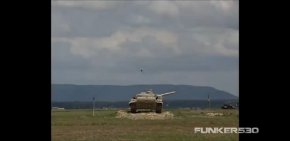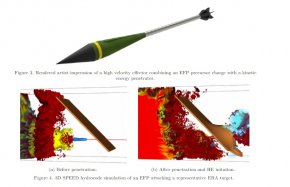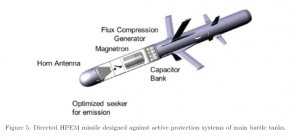Just to share a group of diagrams that I have came across.
Based on it, most tank-based APS currently in use around the world are designed to counter ground threats. For example, the Russian Shtora-1 soft-kill APS used on the T-90 can only jam incoming missiles at up to 25° of elevation. The Russian Drozd hard-kill APS uses fixed, horizontal launchers, so its elevation is even worse, it can only engage incoming projectiles on a perfect horizontal plane. The Afghanit soft/hard-kill APS used by the Armata has 20° of elevation. Arena-M has 20° of elevation as well. The Italian Scudo hard-kill APS has 30° of elevation.
Some APS have better maximum elevation, but they are rare. The German MUSS soft-kill APS has 70° of elevation. The Israeli Trophy* hard-kill APS has an almost vertical maximum elevation (
Big_Zucchini maybe you can help to verify this). However these systems are the exception, most tank-based APS have between 20 and 30° of maximum elevation.
First I'll reply specifically on some mentioned systems.
1)Shtora was designed at a time when the west did not have any top attack munitions. In this case, mounting extra Shtora radiators on top would be counter-productive as it would obscure crew sights, take away valuable turret top real estate, and would be visible to aircraft at a long distance.
Optical effector based APS are very target-specific. The Shtora was specifically designed against TOW missiles, and even then not against all variants.
2)MUSS as far as I know, deploys grenades with various effectors like smoke and potentially chaffs. But I do not recall ever seeing a mount for a 70° elevation.
To truly create such a system, it would need some form of input from an automatic sensor, such as an IR sensor or radar, that would detect the threat, which in turn also requires integration with an FCS. As it stands, the MUSS is not yet integrated with any known FCS and sensor that I'm aware of.
Now I'll speak generally.
These systems you've mentioned, particularly hard kill, are of the old generation. It's much easier to make an APS that has static launchers, and only has to go through 2 logical loops - what is the location and speed of the threat, and when to deploy effector.
In systems that have to respond in split second, timing is a vital aspect of the system design. Any kind of calculation that can be reduced, any excess wire length, are cut.
There's one way I like to think of it - from the moment a certain electron returns to the radar, how much time is wasted inside the computers until he finally reaches the launcher? Of course, that's physically inaccurate, but it does put RF development in perspective.
Today when you look at systems like the Trophy or Iron Fist, you can see a lot of logical loops that this electron goes through - you have to know the location and speed of the threat, but now you also have to create a visual map of it, then you have to draw from a look-up-table all the potential values and calculate which one's closest within a certain measure. And if it doesn't fit anyone, run a separate scenario.
Then you have to calculate the appropriate response based on classification result, calculate the necessary movement of the launcher servos based on their internal (non-zero response time) loop, wait for the non-light speed launcher to rotate, wait for an acknowledge command from the launcher that it's in position, recalculate ballistics to account for timing errors, and send command to launch.
Doing all these back when the static launcher systems were developed, would make them prohibitively slow, maybe even taking whole seconds to launch.
Software refinement is a process that takes a long time, especially when you have to write it in low level languages (low level is a language closer to how a machine understands it. Lowest possible level is writing 1s and 0s. High level is what's closest to human language like Python).
Of course, you've smartly given as example the Afganit. It's not the old Zaslon. So why did Russia opt for static launchers? There is no 100% factual answer I might give here.
But it may help if we looked at Russia's current state of arms development.
I could give examples from their air force, air defenses, or navy, but I'll settle for something on theme - their flagship Armata project, and sister projects Kurganets and Bumerang.
These projects were developed long before their debut in 2015. The Armata itself was developed at least since the 90's in various forms, particularly for its MBT variant.
And yet, since 2015 we've observed 2 conflicting things occur:
1)Russia's economical power has only steadily grown as the sanctions regime against it was already in place by that time, and it was adapting.
2)The programs have only been delayed time after time.
Why's that? Well Russia is still lagging behind the west in technological development. It may not have yet matured many technologies, particularly in electronics, that in the west are seen as a given for many defense companies.
So it is possible they still do not have the technology to progress past static launchers.








